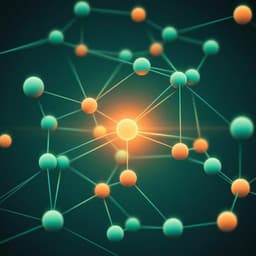
Biology
A de novo matrix for macroscopic living materials from bacteria
S. Molinari, R. F. T. Jr., et al.
This exciting research by Sara Molinari and colleagues unveils the development of engineered living materials (ELMs) using *Caulobacter crescentus* cells. By creatively manipulating a self-interacting protein, they formed centimeter-scale ELMs, revealing new design rules to enhance their properties and functions.
~3 min • Beginner • English
Introduction
Naturally occurring living materials, such as bone and wood, grow from a small number of progenitor cells into macroscopic structures. Engineered living materials (ELMs) aim to emulate and extend this concept by embedding engineered cells within a biopolymer matrix to endow materials with sensing, therapeutic, structural, and other functions. A central challenge is achieving bottom-up growth of macroscopic ELMs from a genetically encoded, synthetic matrix that controls bulk properties. Prior macroscopic ELMs often use top-down fabrication (e.g., 3D printing) with exogenous matrices or modify existing matrices, offering limited genetic tunability of mechanical properties. Achieving self-organization of micrometer-sized cells into centimeter-scale materials requires coordinating interactions across orders of magnitude in length scale, and design principles for such assemblies remain unclear. Motivated by insights from DNA-coated colloids that require high-density surface interactions for macroscopic assembly, and by limitations of bacterial outer-membrane display densities, the authors hypothesized that a high-density, self-interacting protein matrix genetically displayed and secreted by Caulobacter crescentus could drive autonomous assembly into macroscopic ELMs with tunable properties. They designed a modular “BUD” protein based on the S-layer scaffold to test this hypothesis.
Literature Review
The field has produced macroscopic ELMs primarily via top-down incorporation of cells into exogenous matrices or by processing microscopic ELMs into larger forms. Autonomously formed macroscopic ELMs have been created by modifying nanocellulose matrices or by genetic mineralization of silicates, but these approaches allow only modest tuning of mechanical properties (~1.2–1.4-fold changes in storage modulus). Bacterial surface display strategies (e.g., leucine zippers or nanobody/antigen pairs on Escherichia coli) induce cell aggregation but typically yield only microscopic flocs that require further processing. In contrast, DNA-functionalized colloidal particles self-assemble into microscopic and macroscopic crystals when ligands are presented at high surface density (~1 DNA per 27 nm²), suggesting that high-density, specific interactions are critical for macroscopic assembly. The Caulobacter crescentus S-layer (RsaA) enables high-density display (potentially up to one protein per ~270 nm²) and has been engineered for secretion of biopolymers, providing a promising scaffold for a de novo protein matrix that could bridge length scales from cells to centimeter-scale materials.
Methodology
- Strain design and genetic engineering: Starting from a Caulobacter crescentus background lacking the adhesive holdfast to minimize native interactions, the authors replaced the native rsaA gene with a construct encoding the BUD protein. The BUD architecture included: (i) an N-terminal anchoring domain (RsaA residues 1–250) that binds O-antigen LPS for high-density surface display (~14,000 copies/μm²), (ii) an elastin-like polypeptide (ELP) region (e.g., ELP0; variants constructed included ΔELP or altered ELP length) to tune mechanics and add noncovalent self-interactions, (iii) functionalization tags (SpyTag for covalent capture of SpyCatcher fusions and a FLAG epitope), and (iv) a C-terminal RsaA domain (including the secretion subdomain, residues 900–1026) to mediate secretion and self-assembly. Integration plasmids targeted the rsaA locus via two-step homologous recombination; constructs and primer sets are detailed, with verification by colony PCR and sequencing.
- Variants: Constructed strains lacking the ELP region (ΔELPα) and strains with secreted-only BUD (e.g., lacking the anchoring domain; ELPα-250) to dissect roles of display vs secretion in material assembly.
- Culture and growth conditions: Standard growth at 30 °C, 250 rpm shaking in PYE medium (typical 80 mL in 250 mL flasks), with systematic variation of flask diameter, culture volume, and shaking speed to study assembly and scale-up. Assembly tracked over time to capture planktonic growth, pellicle formation at the air–water interface, pellicle collapse, and final material formation.
- Imaging and staining: Confocal microscopy with SpyCatcher-GFP vs GFP controls to verify surface display; AFM to assess surface morphology and layer thickness during early and late stages; electron and optical microscopy to visualize hierarchical material structure; Congo Red (protein/amyloid-associated) and DiO (lipid) stains to identify matrix composition and exclude lysed-cell debris.
- Immunoblotting: FLAG immunoblot of culture supernatants and whole cells to detect BUD protein secretion (observed band ~120 kDa; consistent with known anomalous migration of RsaA-like proteins).
- Assembly dependence on physical parameters: Introduced a phenomenological, “modified volumetric power” parameter (P_V,A) incorporating volumetric power input and oxygen mass transfer to relate shaking/flask geometry to material size. Tested surfactant addition, static vs shaking conditions, and validated P_V,A predictions across scales (e.g., 500 mL flasks).
- Rheology: Strain- and frequency-sweep measurements on a strain-controlled rheometer (cone-plate geometry) to quantify viscoelastic moduli (G′, G″) for original and genetically modified BUD-ELMs.
- Regeneration and processing: Desiccation of materials for 7–21 days followed by reseeding in fresh medium; formation of extrudable pastes; creation of composites with glass powder.
- Functional assays: Cadmium biosorption using ΔSpyTag BUD-ELMs quantified by ICP-MS; catalytic functionalization by incubating BUD-ELMs with SpyCatcher–glucose dehydrogenase (GDH) prepared from E. coli lysates and reconstituted with PQQ, followed by DCPIP/PMS colorimetric assay to verify activity. Controls included non-SpyCatcher GDH and apo/holo enzyme states.
Key Findings
- Autonomous macroscopic assembly: Wild-type Caulobacter (no BUD) did not aggregate, whereas BUD-ELM strains formed visible, filamentous, centimeter-scale materials containing intact cells and large cell aggregates (>50 μm²). SpyCatcher-GFP staining confirmed high-density surface display of BUD, and AFM revealed a brush-like, unstructured projection layer distinguishing BUD-ELM cells from wild type.
- De novo protein matrix: Confocal imaging and staining showed a hierarchical structure with both surface-displayed BUD and a secreted, cell-free protein matrix surrounding cells. Congo Red staining overlapped protein-rich regions; DiO did not stain cell-free matrix, excluding lipid/cell-debris origin. BUD was detected in supernatants (~120 kDa band), demonstrating coexistence of surface-bound and secreted forms during assembly.
- Genetic dissection of roles: Secreted BUD protein was critical for centimeter-scale assembly (matrix-rich materials formed even without display), while surface display promoted cell-rich aggregates and enhanced cell–cell and cell–matrix interactions.
- Multi-step, interface-mediated assembly: Time-course imaging showed a pellicle forming at the air–water interface that densified and collapsed into final materials under shaking. Surfactant prevented pellicle/material formation; static cultures did not form materials unless subsequently shaken. AFM of pellicles showed a ~6 nm protein membrane with peripheral sparse cells and a dense central region.
- Physical parameter governing scale: A modified volumetric power parameter (P_V,A) correlated with material size, identifying an optimal range of ~0.72–1.65 mW/m² for forming the largest pieces. Predictions held during scale-up to 500 mL flasks.
- Tunable mechanics via genetics: All BUD-ELMs behaved as viscoelastic solids. At 10 rad/s, ΔELP20 BUD-ELMs increased storage modulus G′ by ~4.4× and loss modulus G″ by ~4.0× relative to original; the Arsa43,20 variant showed ~3.2× lower G′ and ~6.3× lower G″ than original. Genetic changes modulated G′ and G″ over ~14-fold and ~25-fold, respectively.
- Regeneration and processability: Desiccated materials successfully reseeded new growth with 100% success at 7 and 14 days, and ~33.3% at 21 days. Materials formed cohesive, extrudable pastes and acted as binders to form hardened composites with glass powder.
- Functional performance: BUD-ELMs removed ~90 ± 5% Cd²⁺ from solution within 90 min under tested conditions. Functionalization with SpyCatcher–GDH enabled catalytic glucose oxidation in the material, whereas controls lacking SpyCatcher or cofactor did not show activity.
Discussion
The study addresses the challenge of bottom-up assembly of macroscopic ELMs by genetically encoding a high-density, self-interacting protein matrix in Caulobacter crescentus. The BUD protein simultaneously mediates cell–cell adhesion via surface display and builds a secreted extracellular protein matrix, enabling autonomous formation of centimeter-scale materials. Assembly proceeds via a pellicle at the air–water interface, with hydrodynamic forces driving consolidation into a bulk material. Introducing a modified volumetric power parameter connects culture conditions to material size and enables predictive scale-up. Importantly, the modular BUD design permits substantial genetic control over viscoelastic properties, achieving up to 25-fold modulation of loss modulus, surpassing tunability of prior autonomous macroscopic ELM platforms. Demonstrations of regeneration after drying, extrusion, composite formation, heavy metal removal, and bio-catalysis highlight the multifunctionality and practical advantages of a macroscopic, solid living platform versus suspensions of single cells. Collectively, the findings provide design and assembly rules for programming living cells to self-organize into macroscopic materials with tailored mechanics and function.
Conclusion
This work establishes a bottom-up strategy to grow macroscopic engineered living materials by encoding a modular, self-interacting S-layer–based protein (BUD) in Caulobacter crescentus. The approach yields centimeter-scale materials through a multi-step, air–water interface–mediated process, with predictable scaling using a modified volumetric power metric. Genetic modifications to BUD components enable wide-range tuning of viscoelastic properties (up to 25-fold), while the materials remain processable, regenerable, and functionally adaptable via modular bioconjugation (e.g., SpyTag/SpyCatcher). The platform’s simplicity in culture requirements suggests broad accessibility and potential for applications in remediation, catalysis, and structural composites. Future research should elucidate the molecular nature and strength of self-interactions within the BUD matrix, refine genetic control over matrix composition and crosslinking, explore alternative self-interaction domains, and generalize interface-driven assembly principles to other organisms and material architectures.
Limitations
- Dependence on air–water interface and hydrodynamic conditions: Material formation required pellicle formation at the interface and sufficient shaking; surfactants or static conditions prevented assembly, indicating sensitivity to cultivation parameters.
- Incomplete mechanistic understanding: While secretion and display roles are demonstrated, the precise molecular interactions, self-association mechanisms, and crosslinking dynamics within the BUD matrix remain to be fully characterized.
- Affinity/specificity landscape: The study focuses on specific domains (RsaA fragments, ELP, SpyTag). Broader exploration is needed to define how different self-interaction modules affect assembly, robustness, and mechanical tuning.
- Application-specific performance not fully benchmarked: Heavy metal binding and catalytic activity were demonstrated, but comprehensive capacity, kinetics, long-term stability, and reusability under diverse environmental conditions were not exhaustively evaluated.
- Genetic variants: Some domain deletions (e.g., complete removal of the essential C-terminus) were not feasible, limiting full ablation studies of all module functions.
Related Publications
Explore these studies to deepen your understanding of the subject.







